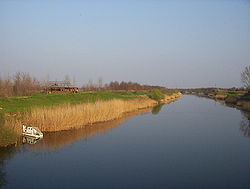Danube-Tisza-Danube canal system
The Danube-Tisza-Danube Canal System ( Canal DTD , Serbian Канал Дунав-Тиса-Дунав Canal Dunav-Tisa-Dunav ) is a system of canals and ditches in the north Serbian lowlands of Vojvodina , Serbia , between the Serbian Danube in the west and the lower reaches the Tisza in the center and the Danube at the Iron Gate . The system thus includes the Batschka and Banat regions north of the Danube , which are separated by the Tisza.
description
The hydraulic structure is used for flood protection, swamp drainage, industrial water supply, sewage disposal, shipping as well as sports and tourism.
The canal system has a catchment area of around 12,700 km². The total length of the built canals is 929 km, including new and old canals and rivers that have been fully or partially reconstructed and integrated into the canal system. The main channel network comprises Structures 51, 24 of contactors 16 locks , security gates 5, 6 pumping stations . There are also 180 bridges and footbridges. There are 14 landing stages and piers for goods transport.
84 bridges (62 road bridges, 19 railway bridges, 3 pedestrian walkways) were built along the newer canals of the system.
One of the most important structures in the canal system is the Tisza barrage near Novi Bečej , which regulates the water regime in the canal system and is also responsible for the irrigation of 3,000 km² of arable land.
Components in the Batschka
The Danube-Tisza-Danube canal system in the Batschka includes:
Great Batschka Canal
The canal, known today as the Great Batschka Canal (formerly: Franzens Canal or King Peter Canal ), was the first canal of today's canal system in Vojvodina. The 118 km long canal was opened in 1803 and connects the Danube at Bezdan via Sombor with the Tisza at Bečej .
Small Batschka Canal
In the 1870s the Kleine Batschka Canal (formerly: Franz-Josephs-Kanal or Alexander Canal ) was built. The 69 km long canal connects Mali Stapar on the Great Canal with Novi Sad on the Danube.
Baja-Bezdan supply channel
Also in the 1870s, the Baja – Bezdáner feed channel, a left side channel of the Danube, was built. The 47 km long canal from Baja (Hungary) to Bezdan is a receiving water coming from the north of the Great Batschka Canal, which is largely located on Hungarian territory.
Other channels in the Batschka
In later decades, other shorter connecting channels were built, including:
- GBK near Sombor - Prigrevica - Srpski Miletić - Karavukovo - Danube near Bogojevo (38 km)
- Danube near Bezdan - Bački Monoštor - Kupusina - Canal 1 near Prigrevica (31 km, partly in oxbow lakes )
- Canal 1 near Karavukovo - Bač - KBK near Bački Petrovac (51 km, parallel to the Danube)
- Channel 1 near Srpski Miletić - KBK near Ruski Krstur (17 km in east-west direction)
- KBK near Savino Selo - Kucura - GBK near Vrbas (14 km)
- KBK near Despotovo - Ravno Selo - Zmajevo - Gospodinci - Tisza near Žabalj (mostly following natural river)
Ingredients in the Banat
The Danube-Tisza-Danube canal system in the Banat includes:
Bega canal
The Bega is canalised from Timisoara and runs via Klek and Zrenjanin to the mouth of the Tisza at Titel .
Werschatzer Canal
The Vršacki Canal runs as follows: Klek - Botoš - Vlajkovac near Vršac - Danube near Socol (start of the Iron Gate )
Other channels in the Banat
Web links
- Interactive navigation map of the Danube, Sava and Tisza - also includes the DTD canal system
